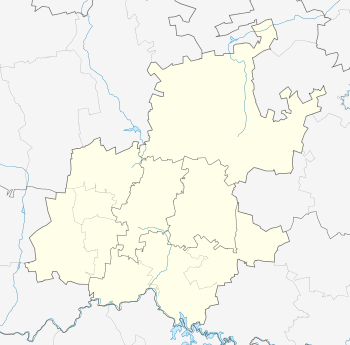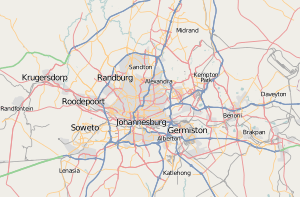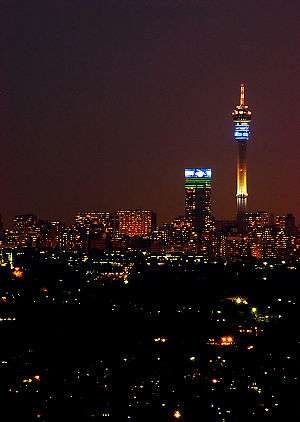Hillbrow
| Hillbrow | |
|---|---|
|
Hillbrow and the Hillbrow Tower | |
 Hillbrow  Hillbrow  Hillbrow
| |
|
Location within Greater Johannesburg  Hillbrow | |
| Coordinates: 26°11′20″S 28°2′56″E / 26.18889°S 28.04889°ECoordinates: 26°11′20″S 28°2′56″E / 26.18889°S 28.04889°E | |
| Country | South Africa |
| Province | Gauteng |
| Municipality | City of Johannesburg |
| Area[1] | |
| • Total | 1.08 km2 (0.42 sq mi) |
| Population (2011)[1] | |
| • Total | 74,131 |
| • Density | 69,000/km2 (180,000/sq mi) |
| Racial makeup (2011)[1] | |
| • Black African | 98.3% |
| • Coloured | 0.9% |
| • Indian/Asian | 0.3% |
| • White | 0.4% |
| • Other | 0.2% |
| First languages (2011)[1] | |
| • Zulu | 36.7% |
| • Southern Ndebele | 16.1% |
| • English | 9.7% |
| • Northern Sotho | 7.1% |
| • Other | 30.4% |
| Postal code (street) | 2001 |
| PO box | 2038 |
| Area code | 010 |

Hillbrow (pronunciation: /ˈhɪlbroʊ/) is an inner city residential neighbourhood of Johannesburg, Gauteng Province, South Africa. It is known for its high levels of population density, unemployment, poverty and crime.
In the 1970s it was an Apartheid-designated "whites only" area but soon became a "grey area", where people of different ethnicities lived together. It acquired a cosmopolitan and politically progressive feel, and was one of the first identifiable gay and lesbian areas in urban South Africa. However, due to the mass growth of the population of poor and unemployed blacks after the end of Apartheid, crime soared and the streets become strewn with rubbish.[2] This, together with lack of investment and fear led to an exodus of middle class residents in the 1980s and the decay of major buildings, leaving in its wake an urban slum by the 1990s.[3]
Today, the majority of the residents are migrants from the townships, rural areas and the rest of Africa, many living in abject poverty. An urban regeneration programme is underway. There are street markets, mainly used by local residents, and the Johannesburg Art Gallery contains work by major local artists including William Kentridge.
In media and fiction
In 2000, Michael Hammon and Jacqueline Görgen directed a documentary named Hillbrow Kids, depicting the struggles of a group of street children in post-apartheid urban South Africa. The 2001 novel Welcome to Our Hillbrow by Phaswane Mpe deals with life in the district in the years after apartheid, focusing on a large number of issues ranging from poverty, HIV/AIDS, and xenophobia.
Hillbrow has also been a setting used by other South African writers: in the 2001 novel, The Restless Supermarket, Ivan Vladislavic comically portrays South Africa's transition to democracy, endowing his narrator, Aubrey Tearle, with the perspective of a conservative white pensioner. Through this lens, Hillbrow becomes representative for the larger post-apartheid nation.
In 2007, BBC Two reporter Louis Theroux ran a documentary called "Law and Disorder in Johannesburg". The documentary depicted the state of complete abandon and lawlessness in some parts of the city, specifically on Hillbrow.
Much of Lauren Beukes' 2010 science fiction novel Zoo City was set in Hillbrow.
In January 2013, Al Jazeera English aired a Witness documentary about Hillbrow described as "A personal journey to Hillbrow, where human spirit, hope and enterprise triumph in this crime-ridden melting pot in the heart of South Africa."
The House Group
In 1990 Jean du Plessis and Adele du Plessis founded The House Group, an organization with several shelters and programs aimed at retrieving and rehabilitating female child victims of commercial sexual exploitation. The organization’s first address in Hillbrow was on 52 Soper Road, close to Ponte City. In 1993 they moved to two adjacent premises on 60 Olivia Road (at the foot of the Hillbrow Tower) where the organization had The House Drop-in Centre and Intombi Shelter.
At the time, in South Africa, there was no legislation allowing The House Group to conduct its mission. Legislation was in effect to help male children, but no legislation allowed for girls in shelters. The lack of a legislative framework disallowed The House Group to continue and authorities tried to shut them down. The founders appealed to the media for help. A barrage of media attention followed that rallied public support and gained international attention. According to The House Group, hundreds of print articles and television exposes occurred over several years.
During 1996, The House Group was invited to deliver papers to the 1st World Congress Against Commercial Sexual Exploitation of Children, held in Stockholm, Sweden. A hundred and fifty countries were represented at the meeting. The organization enjoyed goodwill and sponsorship from foreign governments, most notable the Royal Dutch Government and that of the USA.
During 1997, the Gauteng Provincial Government proclaimed the first legislation that allowed shelters for female children. Jean du Plessis and Adele du Plessis had worked with the ministry over many years to that effect. Subsequent to 1996, hundreds of shelters and programs similar to The House Group sprouted in South Africa. The problem with children and youth victims of commercial sexual exploitation in South Africa, and Hillbrow in particular, is on the increase.
Landmarks
Constitution Hill
The Constitution Hill precinct, seat of the Constitutional Court of South Africa, is located on the western edge of Hillbrow, and is part of a major government and private initiative to revitalize the area and the rest of the CBD.
Hillbrow Tower
The Hillbrow Tower, a telecommunications tower, dominates the Johannesburg city skyline, featured in many picture postcard views of the city. It has become a symbol of the city and appears in the city seal. Completed in 1971, it rises to a height of 270 metres, thus making it the tallest man-made structure with an elevator in Africa. Initially named the JG Strijdom Tower, it became popularly known simply as the Hillbrow tower, and in May 2005 it was renamed to Telkom Joburg Tower, with its new name displayed prominently in lights. It once featured a luxury rotating restaurant, but that was closed in 1981 due to security fears and is unlikely to be reopened.
Ponte City
Ponte City is the tallest residential building in Johannesburg and one of the city's most striking urban landmarks. It was designed by architect Rodney Grosskopff (who also designed other South African landmarks such as the Johannesburg Civic Theatre) and completed in 1975.
The building is distinct due both to its height, rising to 54 storeys above one of the highest points in Johannesburg, as well as its cylindrical shape. During its prime, Ponte City was one of the city's most sought-after addresses, but with inner-city urban decay setting in, it has become run-down, over-populated, and unsafe. The building was placed under new management in 1999, and with regular maintenance reinstated and gradual restoration, coupled with council, provincial, and government initiatives to rehabilitate Hillbrow, it is beginning to find some shine again.
In February 2007, Danny Boyle, the British director of Trainspotting, announced plans to use the building as a film set in a future release.[4]
Books and publications
- Daniel Conway (2009) 'Queering Apartheid: the National Party's 1987 'Gay Rights' Election Campaign in Hillbrow', Journal of Southern African Studies, 35,4: 849–863.
- Glynn Griffiths and Paddy Clay, Hillbrow (Cape Town, Don Nelson, 1982)
- Kgebetli Moele, Room 207 (Kwela Books, 2006)
- Alan Morris, Bleakness and Light: Inner City Transition in Hillbrow, Johannesburg (Johannesburg, University of Witwatersrand Press, 1999)
- Phaswane Mpe, Welcome to Our Hillbrow (Pietermaritzburg, University of KwaZulu-Natal Press, 2001)
- Ivan Vladislavic, The Restless Supermarket (Cape Town, David Philip, 2001)
Music
- Hillbrow by Johannes Kerkorrel, from the album Eet Kreef (Shifty Records, 1989).
See also
- Jerusalema – 2008 South African film portraying life in Hillbrow
References
- 1 2 3 4 "Sub Place Hillbrow". Census 2011.
- ↑ Conway, Daniel (December 2009). "Queering Apartheid: The National Party's 1987 'Gay Rights' Election Campaign in Hillbrow". Journal of Southern African Studies. 35 (4): 849–863. doi:10.1080/03057070903313210.
- ↑ Morris, Alan (1999). Bleakness and Light: Inner-City Transition in Hillbrow, Johannesburg. Johannesburg: University of the Witwatersrand Press.
- ↑ New Danny Boyle project Ponte Tower in first stage of development
External links
| Wikimedia Commons has media related to Hillbrow. |
